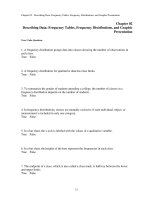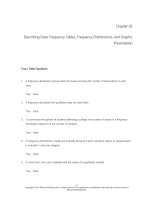Lecture Statistical techniques in business and economics - Chapter 17: Index numbers
Bạn đang xem bản rút gọn của tài liệu. Xem và tải ngay bản đầy đủ của tài liệu tại đây (1.04 MB, 28 trang )
17 1
Copyright © 2004 by The McGrawHill Companies, Inc. All rights reserved.
17 2
When you have completed this chapter, you will be able to:
1.
2.
Describe the term index
Understand the difference between a weighted and
an unweighted index
3.
Construct and interpret a Laspeyres’ price index
4.
Construct and interpret a Paasche’s price index
5.
6.
Construct and interpret a value index
Explain how the Consumer Price Index
is constructed and interpreted
Copyright © 2004 by The McGrawHill Companies, Inc. All rights reserved.
Terminology
17 3
Index Number
… measures the relative change
in price, quantity, value,
or some other item of interest
from one time period to another
Simple Index Number
…measures the relative change
in just one variable
Copyright © 2004 by The McGrawHill Companies, Inc. All rights reserved.
17 4
Mr. Wagner owns stock in three companies.
Shown
below is the price per share at the end of 1996
and 2001 for the three stocks
and the quantities
he owned in 1996 and 2001
1996
1996
2001
2001
Stock Price Shares Price Shares
NWS
$1
30
$2
50
NPC
$5
15
$4
30
GAC
$6
40
$6
20
Copyright © 2004 by The McGrawHill Companies, Inc. All rights reserved.
continued…
17 5
Compute a simple price index for each stock.
Use 1996 as the base year (1996=100)
Stock
1996
Price
1996
Shares
NWS
NPC
GAC
$1
$5
$6
30
15
40
2001
2001
Price Shares
$2
$4
$6
50
30
20
NWS ($2/$1)(100) = 200
Simple Price Indexes are:
NPC ($4/$5)(100) = 80
GAC ($6/$6)(100) = 100
Copyright © 2004 by The McGrawHill Companies, Inc. All rights reserved.
continued…
17 6
Compute a simple index for the number of
shares owned for each.
Use 1996 as the base year
1996 (1996=100)
1996
2001
2001
Stock Price Shares Price Shares
NWS
NPC
GAC
$1
$5
$6
30
15
40
$2
$4
$6
50
30
20
NWS (50/30)(100) = 166.67
Simple Shares Indexes are: NPC (30/15)(100) = 200
GAC (20/40)(100) = 50
Copyright © 2004 by The McGrawHill Companies, Inc. All rights reserved.
Reasons for computing indexes:
Reasons for computing indexes:
17 7
…they facilitate a comparison of
unlike series
Why
Why
Convert
Convert
Data to
Data to
Indexes?
Indexes?
…they are a convenient way to
express the change in the total of
a heterogeneous
group of items
…they allow for a percent
change to be easier to
comprehend than actual
numbers, especially when the
numbers are extremely large
Copyright © 2004 by The McGrawHill Companies, Inc. All rights reserved.
Types of Index Numbers
Types of Index Numbers
17 8
An index can be classified as a:
* price index
quantity index,
value index
or
specialpurpose index
*…this measures the changes in prices from a selected
base period to another period.
Copyright © 2004 by The McGrawHill Companies, Inc. All rights reserved.
Types of Index Numbers
Types of Index Numbers
price index
17 9
Consumer Price Index
quantity index
Retail sales of snowmobiles in Canada
/>value index
Has the value of eggs sold for consumption in 2000
increased from earlier years?
/>
specialpurpose index
S&P/TSX composite
www.tse.com
Copyright © 2004 by The McGrawHill Companies, Inc. All rights reserved.
Types of Index Numbers
Types of Index Numbers
17 10
Industrial Product Price Indexes
…measure the changes in prices received by
Canadian manufacturers for goods as they leave the
factory gate. Indirect taxes, transportation, and wholesale
and retail costs are not included in the price
Raw Materials Price Indexes
…measure price changes for the purchase of raw
materials by Canadian industry.
The term “raw material” refers either to a
commodity that is sold for the first time after being
extracted from nature, or a substitutable recycled
product
Copyright © 2004 by The McGrawHill Companies, Inc. All rights reserved.
Types of Index Numbers
Types of Index Numbers
17 11
New Housing Price Indexes
… measure changes over time in the contractors’
selling prices of new residential houses
…others
Machinery and Equipment Price Indexes
Machinery and Equipment Price Indexes
Nonresidential Building Construction Price Indexes
Nonresidential Building Construction Price Indexes
Farm Input Price Indexes
Farm Input Price Indexes
Farm Product Price Indexes
Farm Product Price Indexes
Price Indexes of the National Accounts (GDP)
Price Indexes of the National Accounts (GDP)
Copyright © 2004 by The McGrawHill Companies, Inc. All rights reserved.
Construction of Index Numbers
17 12
Simple Price Index, P:
Let PO be the base period price, and pt be the price
at the selected or given period.
Thus, the simple price index is given by:
P
Copyright © 2004 by The McGrawHill Companies, Inc. All rights reserved.
pt
po (100)
Construction of Index Numbers
17 13
A weighted index considers both the
price and the quantities of items.
There are two methods of computing the
price index:
Laspeyres method and Paasche method
Laspeyres…
Laspeyres…
Copyright © 2004 by The McGrawHill Companies, Inc. All rights reserved.
Construction of Index Numbers
17 14
Laspeyres’ Weighted Price Index, P:
This method uses the base period quantities as weights.
Let pt be the current price,
p0
be the price in the base period,
and q0
be the quantity consumed in the
base period
p q
P
Copyright © 2004 by The McGrawHill Companies, Inc. All rights reserved.
t
0
p0 q 0
(100)
Construction of Index Numbers
17 15
Paasche’s Weighted Price index, P
…here the present year weights are substituted for the
original base period weights.
Let qt be the current quantity consumed, p0 be the
price in the base period, and pt be the current price.
P
Copyright © 2004 by The McGrawHill Companies, Inc. All rights reserved.
pt qt
p0 qt
(100)
Construction of Index Numbers
17 16
Value index
…here both the price and quantity change
from the base period to the given
period.
A value index reflects changes in both price and
quantity:
V
Copyright © 2004 by The McGrawHill Companies, Inc. All rights reserved.
pt q t
(100)
p0 q 0
Consumer Price Index
17 17
In 1978 two consumer price indexes were
published:
...one designed for urban wage earners and
clerical workers
…another designed for all urban households
Copyright © 2004 by The McGrawHill Companies, Inc. All rights reserved.
Consumer Price Index
17 18
… allows consumers to determine the effect of
price increases on their purchasing power
… it is a yardstick for revising wages,
pensions, alimony payments, etc.
… it is an economic indicator of the rate of
inflation in Canadian
… it computes real income:
real income = money
income/CPI(100)
Copyright © 2004 by The McGrawHill Companies, Inc. All rights reserved.
Consumer Price Index
17 19
Deflating Sales:
Deflated Sales =
Actual Sales
(100)
An approximate index
Determining the purchasing power of the dollar
compared with its value for the base period:
$1
Purchasing power of dollar =
(100)
CPI
Copyright © 2004 by The McGrawHill Companies, Inc. All rights reserved.
17 20
Suppose a person’s income has increased from
Suppose a person’s income has increased from
$44 000 to $54 000 during a 5 year period. Over the
$44 000 to $54 000 during a 5 year period. Over the
same period, the CP has also increased from 100 to 112.
same period, the CP has also increased from 100 to 112
What is the real
What is the rea
value of the increased income of the person?
value of the increased income of the person?
Determine the purchasing power (PP) of the
dollar compared with its value for the base period:
PP at the end of the period = $54000 (100) ==$48
$48214
214
112
The real income increase is only $4 214, due to the
The real income increase is only $4 214, due to the
increase in the cost of living over the 5 years
increase in the cost of living over the 5 years
Copyright © 2004 by The McGrawHill Companies, Inc. All rights reserved.
Shifting the base
Shifting the base
17 21
When two or more series of index numbers
are to be compared,
they may not have the
same base period.
First, select a common base period for all series.
Then, use the respective base numbers as the
denominators and convert each series
to the new base period.
Copyright © 2004 by The McGrawHill Companies, Inc. All rights reserved.
17 22
From the information given, below
perform the following operations:
Compute a simple aggregate price index
Compute a simple aggregate price index
for the three stocks.
for the three stocks.
Stock
1996
Price
1996
Shares
NWS
NPC
$1
$5
30
15
$2
$4
50
30
GAC
$6
40
$6
20
Copyright © 2004 by The McGrawHill Companies, Inc. All rights reserved.
2001
2001
Price Shares
17 23
Compute a simple aggregate price index for the
Compute a simple aggregate price index for the
three stocks.
three stocks.
P
Stock
1996
Price
NWS
NPC
$1
$5
30
15
$2
$4
50
30
GAC
$6
40
$6
20
p t
(100 )
p0
1996
2001
2001
Shares Price Shares
$2 $4 $6
(100 )
$1 $5 $6
Copyright © 2004 by The McGrawHill Companies, Inc. All rights reserved.
100 .0
Using Laspeyres…
Using Laspeyres…
17 24
Computing the price index
using the
SLaspeyres method
pt q 0
P =
( 100 )
Sp 0 q 0
$ 2 ( 30 ) + $ 4 ( 15 ) + $ 6 ( 40 )
=
( 100 )
$ 1( 30 ) + $ 5 ( 15 ) + $ 6 ( 40 )
$ 360
=
( 100 ) = 104 . 35
$ 345
Using Paasche…
Using Paasche…
Copyright © 2004 by The McGrawHill Companies, Inc. All rights reserved.
17 25
Computing the price index
using the
S pPaasche method
t qt
P =
Sp 0 q t
(100)
+ $ 4 (30 ) + $ 6 (20 )
$
2
(
50
)
=
(100)
$ 1(50) + $ 5 ( 30) + $ 6 ( 20)
$
340
=
( 100 ) = 106 . 25
$ 320
Value Index…
Value Index…
Copyright © 2004 by The McGrawHill Companies, Inc. All rights reserved.









